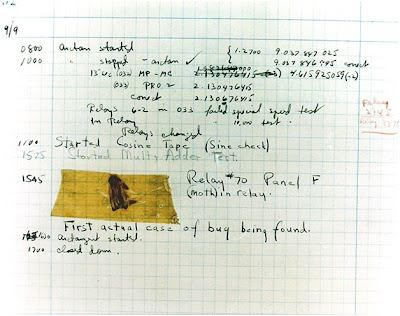Do you know which is the first bug found
The invention of the term "bug" is often erroneously attributed to Grace Hopper, who publicized the cause of a malfunction in an early electromechanical computer.
A typical version of the story is given by this quote:
“ | In 1946, when Hopper was released from active duty, she joined the Harvard Faculty at the Computation Laboratory where she continued her work on the Mark-II and Mark-III (The Harvard Mark II was an electromechanical computer built at Harvard University under the direction of Howard and was finished in 1947. It was financed by the United States navy). Operators traced an error in the Mark II to a moth trapped in a relay, coining the term bug. This bug was carefully removed and taped to the log book. Stemming from the first bug, today we call errors or glitch's in a program a bug. | ” |
Hopper was not actually the one who found the insect, as she readily acknowledged. The date in the log book was 9 September 1947, although sometimes erroneously reported as 1945. The operators who did find it, including William "Bill" Burke, later of the Naval Weapons Laboratory, Dahlgren, Virginia were familiar with the engineering term and, amused, kept the insect with the notation "First actual case of bug being found." Hopper loved to recount the story. This log book is on display in the Smithsonian National Museum of American History, complete with moth attached.
While it is certain that the Harvard Mark II operators did not coin the term "bug", it has been suggested that they did coin the related term, "debug”. Even this is unlikely, since the Oxford English Dictionary entry for "debug" contains a use of "debugging" in the context of air-plane engines in 1945.


Comments
Post a Comment